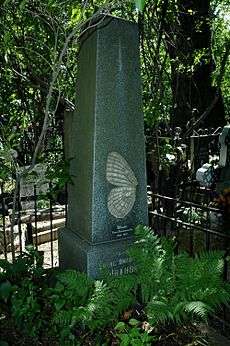Boris Schwanwitsch
Boris Nikolayevich Schwanwitsch (or Schwanwitz), Russian: Борис Николаевич Шванвич, (1889, Poltava – 1957) was a Russian entomologist who specialised in Lepidoptera. He is best known for his studies of the colour pattern of the wings.[1]

Boris Schwanwitz graduated from the St. Petersburg University (1908–1913). After graduation, he changed a number of academic positions: assistant lecturer in Entomology at the Stebut Agricultural School (1915), assistant lecturer (1919) and private-docent (1926) at Petrograd (Leningrad) University, professor at the Perm University (1928–1930).[2] In 1930, he returned to Leningrad (St. Petersburg) to take the position of the head of Entomology department of the Leningrad University (1930–1931 and 1944–1955, 1930 to 1944 the dept. for Entomology was part of the Invertebrate Zoology dept.) Vice-president of the Entomological Society of USSR (1954–1957) and the chair of the Zoology section of the Leningrad Naturalists Society.
In a series of papers he reconstructed the groundplan of the colour-pattern of the wings, first for the Rhopalocera, then for Heteroceran families. He formulated the stereomorphism principle, according to which the cryptic effect of the colour pattern is a result of its 'flattening' (the three-dimensional objects look flat) or 'disjunctive' effect (the two-dimensional objects look like a complex three-dimensional relief). To prove his point he built the plaster three-dimensional models of the lepidopteran wings, the photographs of which looked like an actual colour pattern of stripes and shades (photos were published in a series of papers and in his textbook in entomology). Among his other important contributions are a textbook in entomology with a large morphology section heavily based on Snodgrass and Weber (1949, still in use in Russian Universities), and a book on practical apiculture (1945).
His gravestone is ornamented with a reproduction of the groundplan of the colour-pattern of lepidopteran wings from his textbook.
Selected publications
- On the groundplan of the wing-pattern in nymphalids and certain other families of rhopalocerous Lepidoptera. Proceedings of the Zoological Society of London, ser. B, 34: 509-528 (1924).
- Wing pattern in Papilionid Lepidoptera Entomologist vol. 76 (1943)
References
- "Of Butterfly Wings and Caterpillar Brains". today.duke.edu. Retrieved 2019-04-17.
- Blackwell, Stephen Hardwick (March 22, 2016). Fine Lines: Vladimir Nabokov's Scientific Art. Yale University Press. ISBN 978-0300194555.
External links
- Kluge Phylogenetics